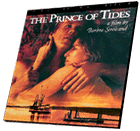

USA drama
1991
color 132 min.
Director: Barbra Streisand
CLV: $99.95 - available
2 discs, catalog # CC1379L
The Prince of Tides is the high-water mark in a long and distinguished
career in cinema. From the phenomenally successful 1968 musical Funny Girl through her
meticulous 1983 rendering of Yentl,
Barbra Streisand had earned her place among the most respected artists in
Hollywood even before she set out on a four-year quest to bring The Prince of
Tides to the screen. In the end, this complex portrayal of the human heart
riven and tormented by impossible passions owes as much to Streisand's personal
struggle to achieve her vision as it owes to the story itself.
Streisand's efforts to film The Prince of Tides began in 1986, when she first looked into Pat Conroy's
bestselling novel. In the four years before the the first cameras rolled in the
spring of 1990, Streisand saw the proposed
film pass through the hands of three would-be producers, survive the collapse of
one film production company and the near-fatal implosion of another. CBS and
MGM/UA each owned the rights for a time, but both companies saw the film in
modest terms, as an intimate, middle-budget drama, perhaps in the cast of Driving
Miss Daisy or The Great Santini -- the sort of intelligent "sleeper"
that would find its audience over time, with careful, gradual coaxing.
Streisand, however, saw The Prince of Tides as a much bolder screen
work, one that could draw audiences quickly, and in large numbers. Her passion
and confidence in the project confounded the Hollywood conventional wisdom. In
the midst of a spate of brat-pack frolics and violent-comic buddy movies,
Streisand was championing a philosophical motion picture whose plot hinged upon a
man confronting childhood trauma and abuse at the hands of adults. The box office
figures indicated that America was
limiting its diet to denial and fantasy, but Streisand aimed to make a film that
would cut through all that, a film that confrontated reality and sought (as her
character, Dr. Susan Lowenstein, does) to heal the psychic wounds we so often
prefer to repress.
Compounding the challenge, Streisand chose not only to direct the film, but to
act and produce as well. Historically a few filmmakers--Orson Welles, Laurence Olivier, Charles
Chaplin--had managed to play all three roles, but even with the support of the
old studio system their efforts were sometimes greeted with only mixed success.
More recently, Warren Beatty, Kevin Costner, and Kenneth Brannagh had pulled off
their own respective hat-tricks, but all with more obviously marketable
properties that could be sold, at least in part, as stories of war and adventure.
Streisand the star may have pulled a core of faithful to the box office, but
Streisand the director made the picture work. The deftness of her touch is
evident throughout, and compares very favorably with the work of directors at
least a generation removed from contemporary Hollywood. The scenes of the
children at play recall the unrestrained gentleness and innocence of George Cukor
(one can't help but think of the opening of The Women, with mother and
daughter rough-housing together), while the scenes of romantic love have an
emotional keenness, a langourous sheen that is virtually absent from today's
graphic, sex-driven cinema.
Most rewarding of all is Streisand's handling of the complex characters she
has drawn from Conroy's book. Her direction has been compared to that of William
Wyler, with whom Streisand worked near the end of his career (and the outset of
her own) on Funny Girl. In certain respects, The Prince of Tides
recalls the most rewarding and underrated of Wyler's films, Dodsworth
(1936): Both pictures are driven by vividly textured, utterly seamless
characterizations, filled with pain, joy, recovery and renewal, and both pictures
feature somewhat improbable romantic leads. Like Walter Huston at the time of
Dodsworth, Nick Nolte was a long established star, but it was not until
Streisand cast him in The Prince of Tides that he finally achieved the
level of charisma that characterizes a romantic leading man -- and no other
director has been able to evoke such a finely tuned performance from him since.
The Prince of Tides established Barbra Streisand as a triple-threat
filmmaker, but perhaps more significantly, it broke important ground for American mainstream cinema, charting new
territory, a more challeging emotional and moral landscape than Hollywood had
explored before. Moviegoers who would never set foot in a revival house suddenly
flocked to the theater to take in the kind of elegantly charged filmmaking
usually associated with Orson Welles
or Marcel Carne. For Streisand, it must have been a vindication of the faith she
had in the art of film itself, its ability to uplift an audience and draw from it
the highest human feelings. Whenever a picture comes along that debunks the
commonly held box-office wisdom, it represents a victory for film art as a whole. The Prince of Tides
is that rarity in modern Hollywood, a work of passion and inspiration, a mirror
of the artist's own grand aspiration, her long struggle and now indisputable
success.
Bruce Eder
CAST
Nick Nolte: Tom Wingo
Barbra Steisand: Susan
Lowenstein
Blythe Danner: Sallie Wingo
Kate Nelligan: Lila Wingo
Newbury
Jeroen Krabbe: Herbert Wodruff
Melinda Dillon: Savannah
Wingo
Bernard Woodruff: Jason Gould
Henry Wingo: Brad
Sullivan
CREDITS
Director: Barbra Steisand
Producers: Barbra Steisand and
Andrew Karsch
Screenplay by Pat Conroy and Becky Johnston, based on the book
by Pat Conroy
Executive producers: Cis Corman and James Roe
Music by: James
Newton Howard
Co-producer: Sheldon Schrager
Director of photography:
Stephen Goldblatt, A.S.C.
Editor: Don Zimmerman, A.C.E.
Production
designer: Paul Sylbert
About the transfer
This exclusive film-to-video
transfer of The Prince of Tides was approved by Barbra Steisand. It was
created using a 35mm low contrast print and a 35mm Dolby Stereo 2-track magnetic
soundtrack print master. The Prince of Tides is presented in its original
aspect ratio of 1.85:1.




